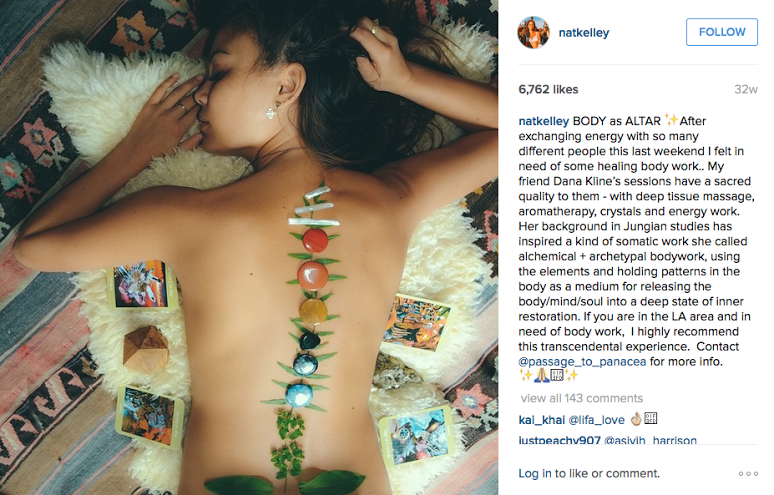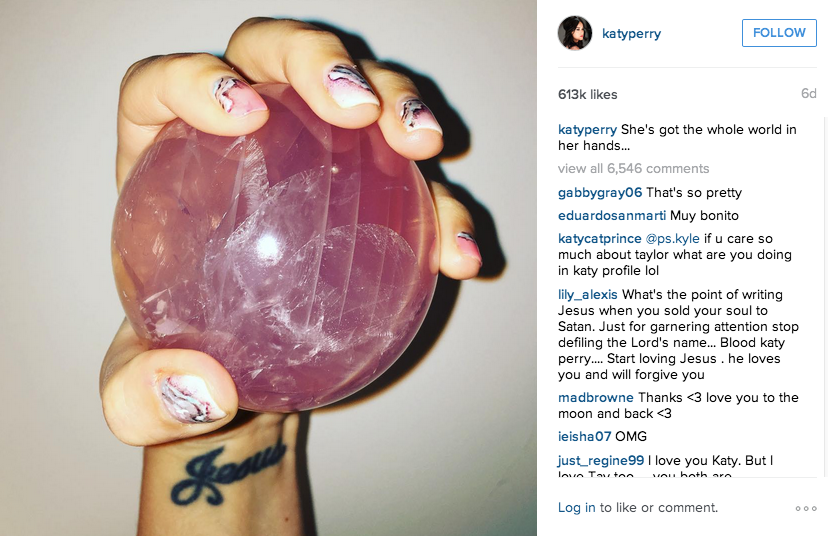My dad convinced me to play hooky from college in 2006 so we could take peyote in our living room with a Navajo chief and a group of my dad’s bohemian friends as a way to heal his cancer.
“You’re such hippies,” people said at the time, with an eye-roll. But times have changed; people are more chill now. All you have to do is scroll through your Instagram feed to witness the widespread ways in which spirituality is entering our lives through social media. Insta-stars like @goddess_rising and Audrey Kitching rack up thousands of followers with dreamy images full of stones, flowers, and elixirs. From crystal healing to religious sermons, dogma has gone digital.

Some might consider me the quintessential Millennial hippie: I’m tattooed with a lotus mandala, I’ve done temazcals in the Tulum jungle, I’ve traveled 10,000 miles tracking down a kebatinan mystic, swear by intenSati workouts, and carry various remedies and amulets. Heck, I’m Facebook friends with my shamans. Growing up, I frequented temples, mosques, churches, shrines and sanctuaries. The freedom to choose my faith enabled me to shape my own spirituality, borrowing customs and beliefs from various religions. I don’t subscribe; I dabble.
Today’s secularization allows us to mix and match practices and ideologies to create an individualized belief system. Social media makes it even easier to publicize and commercialize this flexible spirituality. Just click on the accounts tagged in a photo, and it becomes obvious that a friend wearing a tribal poncho surrounded by dreamcatchers might not just be innocently sharing her spiritual lifestyle, but is actually advertising for the brands that sponsor her posts.
While social media might encourage important, mindful practices in an increasingly mindless world, it can also fail to present an accurate portrayal of the life dedication involved in achieving self-awareness. Mastering meditation takes years, decades, even a lifetime. Daily practice is key to making brain circuitry changes. But today’s insta-spirituality might be as diluted and fragmented as the souls we’re trying to heal. How do we live authentically when #liveauthentic is a trending hashtag? And what role, exactly, does social media play in this new wave of spirituality?
Nowadays it seems everyone’s Ayurvedic, visiting healers, using Headspace, taking ayahuasca, attending Spirit Weavers in The Redwoods, blaming the astrological moon for mood swings, identifying animal totems, or tripping out naked at Burning Man. When cool people with large followings broadcast specific rituals, it’s hard to not be intrigued. Instagram muse Nat Kelley posts healing stones ornamenting her nude back, and I suddenly Google chakras and indulge in Groupon-bought “Psychic Reading with Chakra Necklace or Tarot Card & Palm Reading Session at Spiritual Awakening (Up to 56% Off).”

We previously turned to Thich Nhat Hanh or Sadhguru for spiritual guidance, but social media stars are the new gurus, the modern-day sage-burning metaphysical cheerleaders—live-streaming and proselyting (possibly brand-sponsored) beliefs.
Technology makes it easy to become a “guru”: you can become certified to teach yoga online, or visit totally immersive 3-D virtual ashrams instead of flying to India (in fact, plenty of people now go to church in Second Life versus IRL). Since the insta-spiritual realm is brimming with overnight experts, I fear we’re circulating spiritual dilettantism, propagating bite-sized gospel instead of sparking a global shift toward a more mindful future.
I wonder what it is that propels us to share such deep, personal practices with a public sphere. Most of us wouldn’t leak sex photos, but we seem quick to broadcast something far more intimate. Our underlying intention could be to share newly gained spiritual knowledge and show how #blessed we feel, or it could be another way to say, “Look at me, I’m a trendsetter.”

Buddha said: “Peace comes from within. Do not seek it without.” Yogis who post advanced, body-contorting poses might echo: “Feedback has encouraged me.” But shouldn’t the drive to master something—especially yoga—come from within so we’re mastering it for our own good rather than for the outpour of external validation? We can’t possibly ditch our egos if while meditating we’re also anticipating the likes we’ll get. I question if some of us would still be meditating if we couldn’t prove it online.
Of course, many lead spiritual lives for far deeper reasons than showing off. “My Instagram often contains spiritual elements because that’s what my life consists of.” says actress Nat Kelley. “I don’t believe in meditating for an hour, then being mindless throughout the day. I’m striving for a spirituality that encompasses the entire spectrum of my life.” Kelley practices Zen tea, plant medicine, “ecstatic-shoes-off-crazy-hair-not-giving-a-fuck-kind-of-dancing,” (she runs Dance Church, an underground LA party), Jungian dream analysis, and attends Spirit Weavers—a gathering that educates women with lost skills our grandmothers would’ve taught us back in the day (like starting fires with bare hands, food fermenting, and loom weaving).
Spirit Weavers declined an interview: “We have always felt it best to not open the gathering to press as we aim to keep Spirit Weavers a safe container for women to grow and blossom. It is of the utmost importance to honor the attendees and this sacred space.” I wholly respect this notion-and view their gatherings as enlightening and honest sessions intended to reboot one’s soul. Their intent is to remain a “safe container,” yet Spirit Weavers’ feed showcases participants during ceremonies, sometimes nude. Does Instagram now fall under the umbrella of “sacred space”?

Maybe. “The aesthetic quality of Instagram makes it easy to decide whether somebody’s page aligns with your beliefs and values. Unlike dogma, a picture of a beautiful mandala might spark your own quest for spiritual growth.” Kelley says. “Social media can unite like-minded people who might otherwise never find each other.” Some spiritual leaders liken social media to a return to the inter-tribal social networks of aboriginals.
It’s unsettling to think that soul-enriching practices could be a passing trend in the same way over-the-knee boots were four seasons ago. But Shaman Jon Rasmussen advises me to roll with the punches, to understand that social media is just part of nature. He said: “To me, there is no difference between the birth of a new species in the Amazon and the birth of a new technology in Silicon Valley. It is all Nature, and it is wild, untamable, and dangerous like the jungles, the volcanoes, the oceans, and the animals. So let us not succumb to fear, but instead be courageous in the face of an ever-expanding untamable co-creation that includes social media as an outward expression of the spiritual capability we all have.”
The idea of social media being an unstoppable force, one that can be a valuable tool in expanding our collective consciousness, makes sense to me. But social media can also be used as a weapon, a way to influence others and to cash in on spirituality. Deepak Chopra said: “Social media trends reflect the human condition…We can cause devastation worse than any war through making diabolical use of the social networks, or we could bring the world together in the direction of peace, harmony, sustainability and social justice.” How can we use this technology in a positive way, to uplift and to inspire? I want to strive to always represent the most authentic version of myself—on or off social media. So before I post a photo of my magic wand resting in my palm or use the hashtag #blessed, I’ll check my own ego and more mindfully reflect on the motive of why I even feel the need to share. I want to practice what I post.
Credits
Text Naomi Melati Bishop
Photography Janusz Sobolewski
